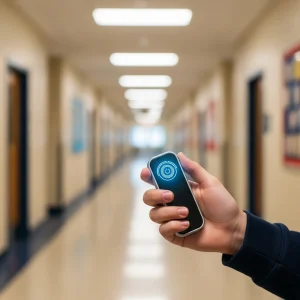In a school emergency, every second before help arrives is agonizing. Traditional emergency communication systems, while well-intentioned, have often proven to be too slow or fragmented when faced with real-time threats. The tragic events at Marjory Stoneman Douglas High School in Parkland, Florida, on February 14, 2018, tragically underscored this critical vulnerability. During the chaos, confusion and delays in communication between school staff and law enforcement were identified as significant hurdles, hindering a rapid response to locate the shooter and victims.
From this tragedy, a powerful movement emerged. Alyssa Alhadeff, a vibrant 14-year-old student who lost her life that day, became the namesake for a life-saving piece of legislation: Alyssa’s Law. Championed by her parents, Lori and Ilan Alhadeff, and the “Make Our Schools Safe” organization, the core idea behind Alyssa’s Law is simple: seconds save lives. It mandates immediate, direct communication with law enforcement during school emergencies, fundamentally changing how schools can respond to crises.
What is Alyssa’s Law? A Direct Line to Safety
At its heart, Alyssa’s Law requires public elementary and secondary school buildings to be equipped with at least one panic alarm for use in a school security emergency. This alarm must be directly linked to law enforcement authorities (911 emergency dispatch). It’s a discreet system signal generated by the activation of a device—whether a wired panic button, a wireless button, or a mobile/computer application—intended to signal a life-threatening or emergency situation requiring an immediate response from law enforcement and other first responders.
Saving Lives: The Power of Speed and Information
The impact of this seemingly simple mandate is profound. By providing a direct, silent alert to authorities, Alyssa’s Law dramatically cuts down on critical response times. Every moment saved means emergency personnel can reach the scene faster, locate the threat more quickly, and begin life-saving interventions sooner. This immediate flow of information is paramount to minimizing casualties and ensuring a more effective crisis resolution.
Alyssa’s Law Beyond State Lines: A Growing National Standard
While born from tragedy in Florida, Alyssa’s Law is rapidly becoming a national standard for school safety. States across the country have already passed similar legislation or have it in progress:
- New Jersey: Passed on February 6, 2019, and went into effect immediately upon passage.
- Florida: Passed on June 30, 2020, with an effective date of July 1, 2020.
- New York: Passed on June 23, 2022, and was effective immediately upon Governor Hochul’s signature. It requires school districts to consider the use of silent panic alarm systems when reviewing and developing their school safety plans.
- Texas: Passed in May 2023 (signed into law May 5, 2023). Schools are required to provide silent panic alert technology beginning with the 2025-2026 school year.
- Tennessee: Passed in May 2023 (signed into law May 10, 2023) , with an effective date of May 10, 2023.
- Utah: Passed on March 12, 2024, and was effective immediately. It requires K-12 public, private, and charter schools to complete detailed safety assessments by December 31, 2024, and implement an Early Warning System.
- Oklahoma: Passed on June 14, 2024, with an effective date of July 1, 2024. It requires school districts to implement a mobile panic alert system.
- Georgia: Passed in April 2025, with an effective date of July 1, 2025. It mandates that all public schools install mobile panic alarm systems directly linked to emergency responders.
- Washington: Passed in May 2025 (signed May 19, 2025), with an effective date of May 19, 2025. This legislation strengthens school emergency response by requiring the use of advanced safety technologies like panic alert systems.
- Oregon: Passed in May 2025 (HB 3083 signed May 28, 2025), with an effective date of May 28, 2025. It mandates all K-12 public and private schools to consider panic alarm systems as part of their school safety planning.
For districts in states that already mandate compliance, implementing silent panic alert technology is a clear requirement. For users in other states where the law is still in progress or not yet passed, this technology is still incredibly valuable. It represents a proactive, best-practice approach to school safety that can save lives, regardless of a legislative mandate. The benefits of immediate, accurate communication in an emergency transcend state lines and legal requirements.
Redbag: Your Partner in Alyssa’s Law Compliance & Beyond
At High Impact Programs, we understand the critical need for effective crisis response. That’s why we partner with cutting-edge solutions like Redbag. As an Account Executive for Redbag, Michael Peck can personally attest that Redbag is fully compliant with Alyssa’s Law. Redbag’s software provides instant campus lockdown via QR code, direct messaging to authorities, teacher check-ins, student accounting, and vital auditing features. This robust platform is not only ideal for K-12 schools but can also be effectively implemented in Higher Education institutions to enhance their emergency response protocols.
Beyond technology, strong emergency plans require expert training and consulting. Michael Peck and High Impact Programs are available to help your district or organization develop and implement comprehensive safety strategies, from reunification planning to emergency operations plan development.
Take Action for a Safer Tomorrow
Whether your state mandates Alyssa’s Law compliance or you’re simply committed to providing the highest level of safety, investing in silent panic alert technology and comprehensive training is a non-negotiable step.
Reach out to us today to discuss the specific needs of your district or organization. Michael Peck is available to help you navigate your options and demonstrate how these solutions can be tailored for your unique environment.
Schedule a call and a demo to see Redbag in action and learn more about High Impact Programs’ training and security consulting services. Every second truly does count.



